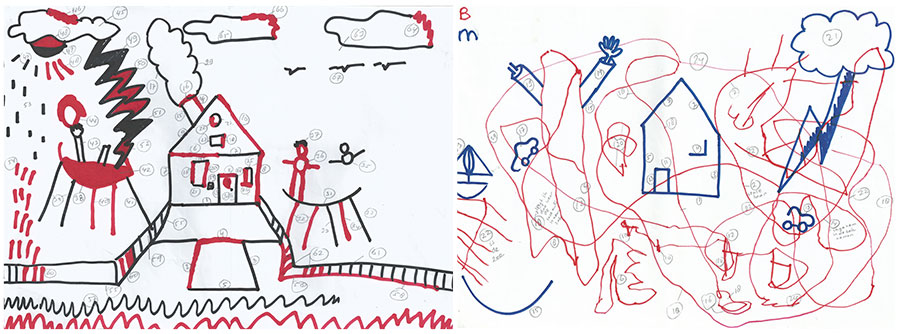aspergers and drawing tiny complex 3d mazes

THIS ARTICLE IS MORE THAN 5 YEARS Former
This article is more than 5 years one-time. Autism research - and science in general - is constantly evolving, and then older articles may contain information or theories that accept been reevaluated since their original publication appointment.
Picture this: Interactive drawings made with a typically developing 6-twelvemonth-former boy (left) and with a 6-year-old boy who has autism (correct).
When I laissez passer a pint of water ice cream back and forth with my husband (don't judge) and hand the spoon to him later on taking a few bites — rather than eating half the carton on my own — I'm demonstrating an important social skill that scientists phone call reciprocity.
Reciprocity tin mean taking turns, simply too something more — the flexibility to piece of work together with others to shape a conversation, a game or other social interaction. Children with autism often struggle with reciprocity, and poor reciprocity is among the new diagnostic criteria for the disorder in the latest edition of the "Diagnostic and Statistical Transmission of Mental Disorders." Only clinicians lack tools to measure information technology.
Dutch researchers promise to fill up this void with a whimsical exam described 29 January in the Journal of Autism and Developmental Disorders. The 10-minute assessment starts with unproblematic instructions from the tester to the kid: "We are going to draw together."
The researchers focused on cartoon because information technology can capture the implicit nature of taking turns without relying on conversation, a plus when testing children with poor verbal abilities. Information technology may also enable more authentic readings in high-functioning children with autism, who cannot use vocabulary to embrace up their social deficits as they tend to do when the task is verbal.
For the assessment, the tester and child take turns adding elements such as a house or a tree to a mutual cartoon. The kid earns points for contributing to the same feature as the tester — such equally adding leaves to a tree — for going with the flow when the tester changes some role of the drawing and for passing the paper back across the table at the end of a plough. All iii behaviors evidence sensation of unstated social rules about taking turns and a willingness to interact to create a meaningful image.
Surreal sketch:
Researchers tried the examination in 131 children aged half dozen to 18 with autism and 62 age-matched children without the disorder. The autism group achieved lower scores overall. But the biggest differences between the two groups emerged when the tester added new objects to a scene or changed an object or detail that the child had begun drawing.
The results suggest that children with autism tend to exist better at reciprocity when they are in command of the narrative.
That is, when a kid with autism begins drawing a tree, she is not too bad at going back and forth with the tester to add together details such every bit leaves, apples and bark. But if the tester adds something new to the scene, such as the outline of a house, the child might ignore the house and go along working on the tree or start drawing a car instead.
Past dissimilarity, a typically developing child is likely to add to the visual concept that the other person initiated. For instance, when I tried the exercise with my 7-year-onetime daughter, I drew a stick effigy throwing a ball and she immediately added another stick figure to catch it.
Other differences between the groups sally when an object the child initiated changes direction. If a kid begins sketching a automobile and the tester turns it into a burn truck, for example, a typically developing child tends to run with the new narrative, adding a fireman behind the wheel. But a kid with autism might scratch out the transformed car to go along the drawing in line with his original vision.
Ane example of an interactive drawing made with a child who has autism features a fragmented firm, a couple of cars with an exuberant scribble for a racetrack and a cloud with artillery. The resulting illustration reminds me of the collaborative drawings produced by French surrealists in the 1930s.
It's non surprising that narrative command facilitates reciprocity in people with autism. Many affected individuals fluently chat about their own interests but struggle to keep upwards the conversation when the topic shifts. Through drawing, the true nature of the difficulty becomes more than apparent: Rather than having difficulty taking turns speaking, people with autism may struggle to follow some other person's lead in a conversation. This insight may lead to targeted interventions for the disorder.
In the meantime, at to the lowest degree one other reciprocity test is as well in the works: a video-based exam that so far captures variations in reciprocity among typically developing toddlers, as researchers reported in the Journal of Kid Psychology and Psychiatry in Feb. Together, the two tests might help scientists and clinicians get to the lesser of reciprocity, spoonful by spoonful.
Source: https://www.spectrumnews.org/opinion/test-draws-on-doodles-to-spot-signs-of-autism/
0 Response to "aspergers and drawing tiny complex 3d mazes"
Post a Comment